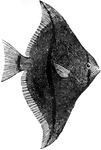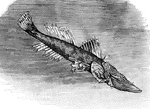87 illustrations of fish including: eel, flatfish, flathead, flounder, flying fish, fork-beard, foureyes, gar, gilt-head, globefish, goby, goldfish, goramy, graining, grayling, grouper, and gudgeon, gunnel, gurnard, and gwyniad
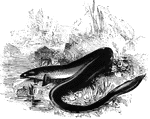
Common European Eel
"These have an elongated form, and a soft, thick, slimy skin; the scales are very minute, and imbedded…

Conger Eel
"It varies in length from three to ten feet, and in weight from five to one hundred and thirty pounds.…

Conger Eel
"Conger is a large sea-eel, 5, 6, or, in rare cases, even 10 feet long. Its upper parts are brownish-white,…
Electric Eel
The electric eel, Electrophorus electricus, is a species of fish. It is capable of generating powerful…

Electric Eel
The Electric Eel (Electrophorus electricus) is a fish in the Gymnotidae family of naked-back knifefishes.

Moray Eel
Moray eels are large cosmopolitan eels of the family Muraenidae. There are approximately 200 species…

Sea Eel
A sea eel that can grow up to 10 feet in length and weigh 100 pounds. Usually a brownish green.
Sharp-Nosed Eel
"It is from one to four feet long, and weighs from one to twenty-five pounds. This species feed on frogs…

Sharp-Nosed Eel
The sharp-nosed eel (Anguilla acutirostris) is a is also known as the European eel (Anguilla anguilla).

Snipe Eel
"An eel-like fish, Nemichthys scolopaceus; any member of the Nemichthyidae. The snipe eel attains a…
Snubnosed Eel
The Snubnosed Eel (Simenchelys parasitica) is a fish in the Synaphobranchidae family of cutthroat eels.

Elephantfish
The Elephantfish (Callorhinchus callorhynchus) is a species of fish in the Chimaeriformes order of chimaeras.

European Bullhead
The European bullhead, Cottus gobio, is a fish of the Cottidae family that is widely distributed in…
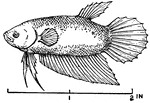
Fighting Fish
Betta pugnax, also known as the Fighting Fish (on account of its pugnacious habits), is a bony fish…
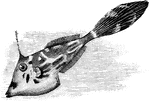
Orange Filefish
The Orange Filefish (Aluterus schoepfii) is a species of fish in the Monacanthidae family of filefish,…

Flying Fish
"The Flying fish, with wings expanded and elevated in the act of flight. This anomalous and interesting…
Garpikes Fish
The gars, or garpikes, are members of the Lepisosteiformes (or Semionotiformes), an ancient order of…
Garpikes Fish
The spotted Gar (Lepisosteus oculatus) is a primitive freshwater fish of the family Lepisosteidae, native…
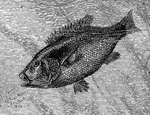
Hussar Fish
An illustration of the Hussar fish which is nest building fish which can be found in the Sea of Galilee.…
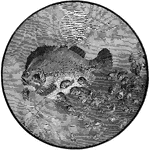
Lump Fish
An illustration of the Cyclopterus lumpus or "lump-fish" found commonly on the coast of Maine. These…

Remora Fish
A genus of fished included in the Goby family, and of which the common remora or sucking fish, is the…

Flatfish
An unsymmetrical fish with both eyes on one sides of its face; one side colored and the other colorless.

Flounder
Flounder keep near the bottom, swimming on one side, and the two eyes are both on the side that is uppermost.

Flounder
"Is found at the mouths of nearly all European rivers, and is especially abundant where the bottom is…

Flounder
A common fish known for its flat appearance and both eyes being on the upper, darker side of its body.

Flounder
Flounder (also; fluke) are flatfish that live in ocean waters ie., Northern Atlantic and waters along…

American Fourspot Flounder
The American Fourspot Flounder (Hippoglossina oblonga) is a fish in the Paralichthyidae family of large-tooth…

Lefteye Flounder (Scaldfish)
The scaldfish (Arnoglossus laterna) is a species of lefteye flounder of the Bothidae family.

Flying Fish
The Flying Fish is enabled to fly by having fins which approach in extent the wings of a bird, (Hooker,…

Flying Fish
"Is twelve to fourteen inches long, and has the ventral fins placed anterior to the middle part of the…

The Flying Fish (E. Volitans)
"These Flying-fishes in their common element are harassed by the attacks of other inhabitants of the…

California Flying Fish
The California Flying Fish (Cheilopogon pinnatibarbatus californicus) is the largest species in the…

Great Forked-Beard
"One to two feet long, with a long barbule hanging from each chin." — Goodrich, 1859
Four Eyes
"There are several species of the genus, Anableps, the principal one being Four Eyes, inhabiting the…
Gar
The gar fish has a cylindrical body covered by rhomboidal bony scales that are coated with enamel, making…

Gar
"Two feet long, with the under jaw greatly protruded; it swims near the surface; bites at a hook; makes…
Shortnose Gar
The Shortnose Gar (Lepisosteus platostomus) is a fish in the Lepisosteidae family of garpikes.
Gar-Pike
"The gar-pike (Lepidosteus osseus), a Ganoid fish, now living in North American rivers." -Taylor, 1904

Gilt-Head
"Twelve inches long, abundant in the Mediterranean, and found on the coasts of Africa and Europe, from…

Gilt-Head
"Six to eight inches long, its general color being red varied with green." — Goodrich, 1859

Globefish
"Tetraodon have a remarkable power of inflating their bodies by filling their stomachs with air, the…

Pennat's Globefish
"Is found in Europe; it occasionally happens that this, as well as other species, when they have puffed…

Black Goby
"It is five to six inches long, and found on the rocky coasts of Europe. It is not esteemed for food."…

Gold Fish
The Goldfish, Carassius auratus, was one of the earliest fish to be domesticated, and is still one of…

Goldfinny
"Is two to five inches long, found in Europe, but less abundantly than most other species." —…
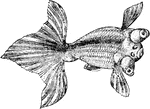
Goldfish
"In China and the warmer parts of Japan a fish extremely similar to the Crucian carp of Europe is of…




